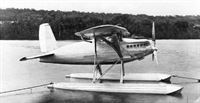
Nieuport-Delage Ni-D 121 - Ni-D 125
Созданный на базе проекта Nieuport-Delage Ni-D 120, одноместный истребитель Ni-D 122 имел неубирающееся шасси с обтекателями на колесах. Его отличало крыло эллиптической в плане формы с уменьшенной толщиной центральной секции и из-за близкого расположения к фюзеляжу с большим вырезом для пилота и ветрового козырька. Вариант Ni-D 121, взлетевший в ноябре 1932 года, отличался 650-сильным (485 кВт) ПД Lorraine 12Hars Petrel, установленным вместо 690-сильного (515 кВт) мотора Hispano-Suiza 12Xbrs, ставившегося на Ni-D 122. Потеря Ni-D 122 во время официального демонстрационного полета 13 апреля 1933 года лишь ускорила разработку новой модели, и в феврале 1934 года был построен Ni-D 123. Он мог оснащаться либо колесным, либо поплавковым шасси и получил компенсаторы на всех поверхностях управления - новинка, позднее принятая многими производителями авиатехники. Варианты Ni-D 121 и Ni-D 124 (перестроенный Ni-D 122) оснащались новым оборудованием. Два самолета Ni-D 125, взлетевшие в апреле и июне 1934 года, получили ряд доработок, включая увеличенный вырез в крыле, увеличенное поперечное V крыла, усиленные стойки шасси. Самолеты оснащались двигателем Hispano-Suiza 12Ycrs мощностью 860 л. с. (641 кВт), а вооружение из двух пулеметов было дополнено 20-мм мотор-пушкой, стрелявшей через кок винта. Максимальная скорость Ni-D 125 составляла 400 км/ч (у Ni-D 121 - 370 км/ч), при этом все варианты самолетов этого семейства демонстрировали высокую маневренность и отличную скороподъемность. В 1935 году партия из шести гидроистребителей Ni-D 123H была поставлена Перу; эти самолеты с двухпоплавковым шасси развивали максимальную скорость 320 км/ч.
- Описание
Фотографии
-
Aviation Historian 33 / A.Tincopa - Wings over Peru
A port-side view of the 121C1 at Villacoublay. Although the prototype displayed an impressive turn of speed and a high degree of manoeuvrability, it was passed over by the French in favour of the more conventional Dewoitine D.500 low-wing monoplane.
-
Aviation Historian 33 / A.Tincopa - Wings over Peru
The prototype NiD 121C1 at the Nieuport-Delage factory at Villacoublay in late November 1932. The 121C1’s Lorraine Petrel liquid-cooled engine was an upright V12 with two banks of six cylinders, arranged at 60° to each other, driving a common crankshaft, and was used to power a number of French aircraft of the 1930s.
-
Aviation Historian 33 / A.Tincopa - Wings over Peru
A line-up of NiD 121C1s of 2 Escuadron de Caza before their deployment to Vitor in Arequipa Province in January 1937. The following year Peru began another rearmament process, acquiring much more modern American fighters, including the Curtiss Hawk 75A-8 and Douglas 8A.
-
Aviation Historian 33 / A.Tincopa - Wings over Peru
At least six NiD 121C1s and four Potez 390A2s (A2 refers to the French Artillerie Biplace - two-seat observation aircraft - specification designation) are visible in this rare photograph of a CAP ceremony at Las Palmas airfield in September 1936.
Другие самолёты на фотографии: Potez Potez 37 / 39 / 49 - Франция - 1930
-
Aviation Historian 33 / A.Tincopa - Wings over Peru
A CAP NiD 121C1 starts its take-off run from the grass runway at Las Palmas in early 1937. The Cuerpo de Aviacion del Peru was formed in May 1929 and renamed the Cuerpo Aeronautico del Peru in 1938. By the mid-1980s the CAP was equipped with a motley collection of various types from the UK, America, Italy and France.
-
Aviation Historian 33 / A.Tincopa - Wings over Peru
The NiD 121C1 prototype, powered by a 650 h.p. Lorraine 12Hars Petrel engine, shows off its classic 1930s lines during a photographic sortie. Note the cutout in the centre section of the parasol wing, which provided the pilot with a good field of vision in all directions; also the radiator slots incorporated into the wings’ leading edges.
-
Aviation Historian 33 / A.Tincopa - Wings over Peru
Самолет Ni-D 121 был одним из 27 участников в конкурсе на новый истребитель, но победителем стал Dewoitine D.500.
The Ni-D 121 was one of 27 submissions to meet a 1930 requirement for which the Dewoitine D.500 was eventually selected.
Another fine view of the NiD 121C1 prototype in flight, showing more of the unusual wing-mounted radiator configuration. Although such an arrangement was an ingenious way of keeping overall drag down, it made the fighter unacceptably vulnerable to enemy gunfire, a single well-aimed wing hit being potentially disastrous. -
Мировая Авиация 205
Ni-D 122 впервые взлетел 23 июля 1932 года. На снимке: первый самолет, списанный после аварии, произошедшей при его летной демонстрации представителям французского парламента.
-
Aviation Historian 33 / A.Tincopa - Wings over Peru
The Hispano-Suiza 12Xbrs-powered Nieuport-Delage NiD 122C1 at the Centre d’Essais de Materiels Aeriens at Velizy-Villacoublay in July 1932. The Nieuport-Astra company was renamed Nieuport-Delage in the 1930s in honour of Gustave Delage, the company’s chief designer and manager during the First World War.
-
Мировая Авиация 205
Ni-D 125 отличался также системой охлаждения, состоявшей из трех панелей из мелких трубок на нижней поверхности крыла.
-
Aviation Historian 33 / A.Tincopa - Wings over Peru
The 121C1 prototype fitted with floats for trials at Sartrouville, north-west of Paris. On July 18, 1934, a NiD 123C1 floatplane version fitted with a Lorraine 12Hdrs engine was evaluated by the CAP commission, which found its characteristics unsatisfactory and advised against its purchase. The CAP still acquired a total of 12 NiD 121C1s.
-
Aviation Historian 33 / A.Tincopa - Wings over Peru
The NiD 121C1’s narrow and rather spindly undercarriage was the cause of several accidents during the type’s career with the CAP. On May 9, 1935, NiD 121C1 serial 4-C-5 of the 4° Escuadron Mixto sustained substantial damage while taxying back to the hangars on the beach at Alferez Carlos Huguet seaplane base in Ancon.
-
Flight 1935-11 / Flight
Nieuport Delage 125 C.1 (France).
-
Air International 1989-01 / Fighter A to Z
The HS 12Xbrs-powered Ni-D 122 which, like the Ni-D 121, featured an unorthodox engine cooling system.
- Фотографии













